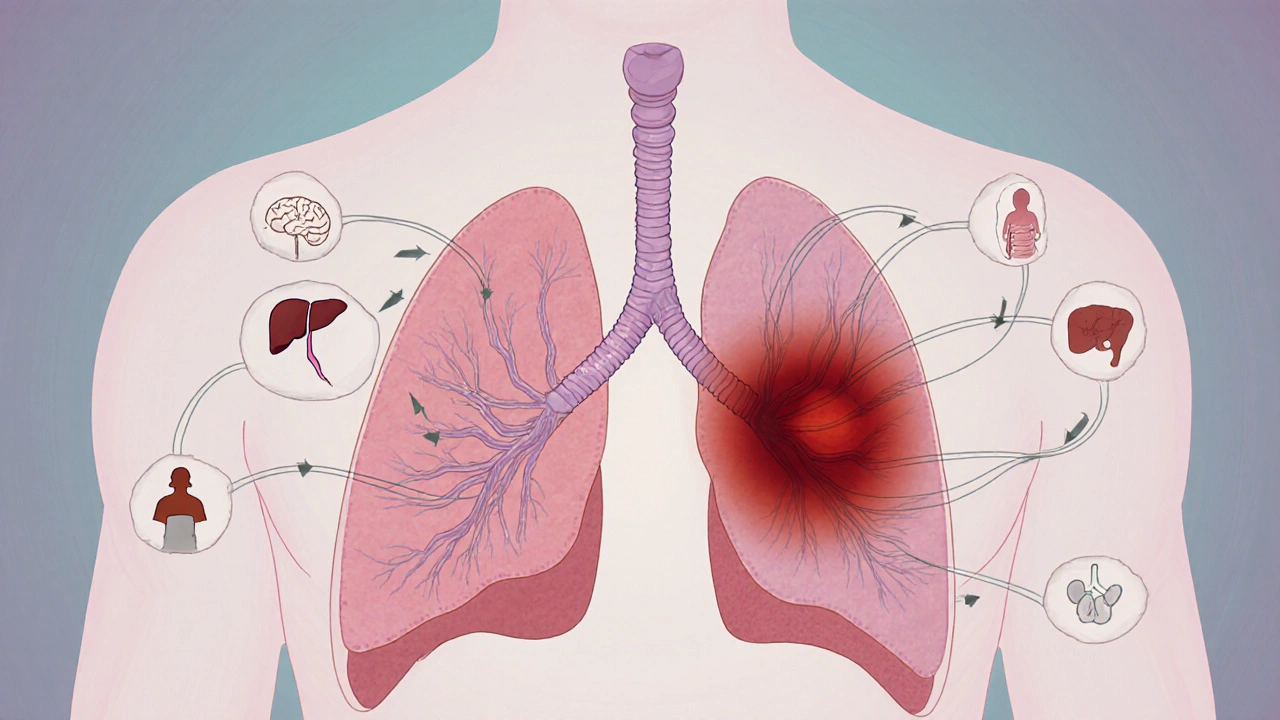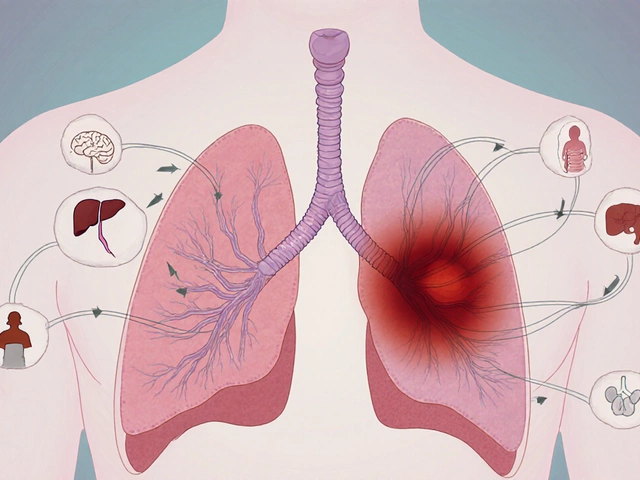
Stage4 Cancer Survival: How Long Can You Expect to Live?
Stage 4 Cancer Survival Estimator
About This Tool
This interactive estimator provides a general idea of median survival times for common Stage 4 cancers. These estimates are based on current medical data and should not replace professional medical advice.
Estimated Survival Time
months median survival
Based on selected factors and current medical data
Facing a diagnosis of Stage 4 cancer is the most advanced stage, indicating that the disease has spread (metastasis) to distant organs brings a flood of questions. The most pressing one is often, “How long will I live?” While no answer can be 100% certain, understanding the factors that shape survival can give you a realistic picture and help you make informed choices.
What "Stage 4" Actually Means
In oncology, cancer stages range from I (early) to IV (advanced). Metastasis is the process by which cancer cells break away from the original tumor and travel through the bloodstream or lymphatic system to form new tumors elsewhere. When this occurs, doctors label the disease as Stage4. The location of the spread (lungs, liver, bones, brain, etc.) and the type of original cancer dramatically affect prognosis.
Key Factors That Influence Survival
- Type of Cancer: Some cancers, like certain lung or pancreatic cancers, tend to have shorter median survival times than others, such as metastatic breast or prostate cancers.
- Extent of Spread: A single metastatic site often predicts a better outcome than widespread organ involvement.
- Patient Health: Age, performance status, comorbidities, and organ function can either limit or broaden treatment options.
- Biomarkers & Genetics: Mutations (e.g., EGFR, HER2) may open doors to targeted therapies that extend life.
- Treatment Access: Availability of cutting‑edge therapies, clinical trials, and supportive care makes a measurable difference.
Median Survival by Cancer Type
"Median survival" means that half the patients live longer and half live shorter than the listed time. It’s a more useful barometer than an average because extreme outliers don’t skew the number. Below is a snapshot of 2024 data from major oncology societies. Keep in mind that these are population‑level figures, not guarantees for any individual.
| Primary Cancer | Median Survival (months) | Typical Effective Treatments |
|---|---|---|
| Non‑small cell lung cancer | 8-12 | Immunotherapy, targeted therapy, chemotherapy |
| Pancreatic adenocarcinoma | 4-6 | Combination chemotherapy (FOLFIRINOX), clinical trials |
| Metastatic breast cancer (HR‑positive) | 24-36 | Endocrine therapy, CDK4/6 inhibitors, targeted agents |
| Metastatic colorectal cancer | 12-18 | Chemo‑biologic regimens, anti‑VEGF/EGFR agents |
| Metastatic prostate cancer | 30-42 | Hormone therapy, androgen‑axis inhibitors, PARP inhibitors |

Treatment Options That Can Extend Life
Even at Stage4, many therapies aim to slow disease, shrink tumors, and sometimes add years to survival. Here’s a quick rundown of the main modalities, each marked up for clarity:
- Chemotherapy is a systemic treatment that uses drugs to kill rapidly dividing cancer cells. It remains a backbone for many solid tumors.
- Immunotherapy is a class of drugs that boost the body’s own immune system to recognize and attack cancer cells. Checkpoint inhibitors (e.g., pembrolizumab) have produced durable responses in melanoma, lung, and renal cancers.
- Targeted therapy is treatment that zeroes in on specific genetic mutations or proteins driving tumor growth. EGFR, ALK, BRAF, and HER2 inhibitors are prime examples.
- Radiation therapy is high‑energy beams used to shrink tumors or relieve pain in specific sites. It’s often combined with systemic treatments.
- Palliative care is specialized medical care focused on relieving symptoms, improving quality of life, and supporting patients and families. It’s not just end‑of‑life; it works alongside curative intent treatments.
- Clinical trial is research studies that test new drugs, combinations, or procedures, often offering access to cutting‑edge therapies before they’re widely available. Participation can be a game‑changer for survival.
Understanding the Numbers: Median vs. Individual Outcomes
Seeing a median of 8 months for Stage4 lung cancer can feel bleak, but it’s only a statistical midpoint. Some patients defy the odds, living years beyond that figure thanks to personalized therapy, excellent performance status, or enrollment in a trial. Conversely, others may experience rapid progression.
Key points to keep in mind:
- Survival curves are not linear; many patients experience a plateau after the first year if they respond to treatment.
- Biomarker‑driven therapy can shift the curve dramatically-think of EGFR‑mutated lung cancer patients who now see median survivals exceeding 20 months with targeted drugs.
- Supportive measures (nutrition, pain control, mental health) can improve overall well‑being and sometimes extend life.
Practical Steps You Can Take Today
- Ask for a detailed prognosis: Request a written estimate that includes median survival, possible ranges, and factors specific to your case.
- Seek a second opinion: A fresh set of eyes may identify clinical trials or novel regimens you haven’t considered.
- Explore clinical trials: Use registries such as ClinicalTrials.gov or your cancer center’s trial navigator.
- Engage palliative care early: Studies show that early integration improves symptom control and can even lengthen survival.
- Maintain a healthy lifestyle: Balanced nutrition, moderate activity, and stress‑reduction techniques help your body tolerate treatment better.

When to Re‑evaluate Goals of Care
As treatment progresses, you’ll periodically reassess whether the focus remains on extending life, improving quality, or both. Open conversations with your oncologist, family, and a palliative‑care specialist are essential. If disease stability is achieved, you might shift toward maintenance therapy and symptom management.
Bottom Line
There’s no one‑size‑fits‑all answer to “How long will I live with Stage4 cancer?” The reality sits somewhere between the raw stage 4 cancer survival statistics and the individual nuances of your biology, treatment choices, and support system. Armed with knowledge about median survival, treatment options, and caring resources, you can make choices that align with your values and goals.
Frequently Asked Questions
What does a median survival of 8 months really mean?
It means that half of the patients lived longer than 8 months and half lived less. Some patients may exceed this time considerably, especially if they receive targeted or immunotherapy.
Can I still receive curative treatment at Stage4?
Usually the goal shifts to control and palliation, but in rare cases-like isolated brain metastasis that can be surgically removed-curative intent may still be pursued.
How do clinical trials affect my chances?
Trials give access to innovative drugs that aren’t yet standard care. Participation can extend survival, especially when standard options are exhausted.
Is palliative care only for end‑of‑life?
No. Early palliative care improves symptom control, reduces hospitalizations, and can even add months to life when combined with active treatment.
What lifestyle changes help me cope?
Focus on a balanced diet rich in protein, stay lightly active (walks, yoga), practice mindfulness or meditation, and keep regular communication with loved ones and support groups.

Arnav Singh
I am a health expert with a focus on medicine-related topics in India. My work involves researching and writing articles that aim to inform and educate readers about health and wellness practices. I enjoy exploring the intersections of traditional and modern medicine and how they impact healthcare in the Indian context. Writing for various health magazines and platforms allows me to share my insights with a wider audience.
Popular Articles
About
Medical Resource Center India is a comprehensive online platform dedicated to providing reliable health information and medical resources in India. Explore a wide range of articles, tips, and advice on medicine, healthcare services, and wellness. Stay informed about the latest developments in Indian medicine and access valuable insights into maintaining a healthy lifestyle. Discover expert guidance and health solutions tailored for every Indian citizen. Your go-to destination for authoritative medical knowledge in India.






